

Their colorful feathers and sweet-sounding songs are a pleasure in the garden. And the also do much more! Garden birds play a critical role for biodiversity: they control dangerous pests, spread seeds, and help pollinate plants. Start off with learning how to identify these few birds, and you’ll surely want to find ways to attract them you your garden!
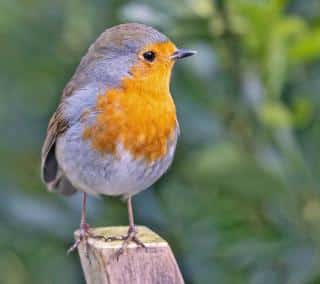 With its short, stocky silhouette, the robin is the easiest to recognize in the garden thanks to its red-orange breast and underside. The rest of its body has brown and green feathers. About 6 inches long (15 cm), Erithacus rubecula is actually quite tame. It isn’t afraid to come watch gardeners from up close, and lives in forest-filled areas. This bird often nests in the lush growth of virginia creeper on houses. When it sings, it hits high-pitched notes that sound a bit harsh, like short screeches.
With its short, stocky silhouette, the robin is the easiest to recognize in the garden thanks to its red-orange breast and underside. The rest of its body has brown and green feathers. About 6 inches long (15 cm), Erithacus rubecula is actually quite tame. It isn’t afraid to come watch gardeners from up close, and lives in forest-filled areas. This bird often nests in the lush growth of virginia creeper on houses. When it sings, it hits high-pitched notes that sound a bit harsh, like short screeches.
Read also → Feeding birds in winter
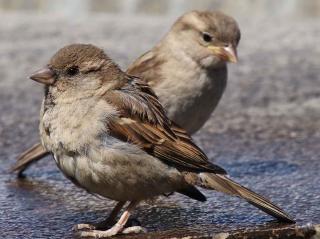 The house sparrow, Passer domesticus, lives in urban or remote areas, but always near farms. This bird is hard to find in the wild, it prefers living wherever man lives. It mostly feeds off seeds it picks from fields. In cities, it is happy picking crumbs off the ground left and right. In fact, this little curious bird even finds its way into houses to see if there’s anything to nibble there! Roaming around in groups, sparrows also eat insects, larvae, and plant buds.
The house sparrow, Passer domesticus, lives in urban or remote areas, but always near farms. This bird is hard to find in the wild, it prefers living wherever man lives. It mostly feeds off seeds it picks from fields. In cities, it is happy picking crumbs off the ground left and right. In fact, this little curious bird even finds its way into houses to see if there’s anything to nibble there! Roaming around in groups, sparrows also eat insects, larvae, and plant buds.
Its belly and neck are gray, but the head and back are brown. Females have lighter colors than males, and black spots dot their topsides. This bird is clearly a tweeter, meaning it sings with short, high-pitched bursts.
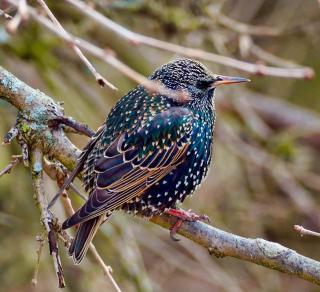 This easy-to-identify bird, the common starling, has dotted feathers. About 8 inches long (20 cm), Strunus vulgaris has dark feathers with dark green flashes. Its beak is orange. The tip of each feather is creamy-white, which gives this “dotted” appearance. This bird lives in groups, and roosts together all year-round, except during the nesting season.
This easy-to-identify bird, the common starling, has dotted feathers. About 8 inches long (20 cm), Strunus vulgaris has dark feathers with dark green flashes. Its beak is orange. The tip of each feather is creamy-white, which gives this “dotted” appearance. This bird lives in groups, and roosts together all year-round, except during the nesting season.
It eats insects, worms, fruits… and even slugs. Short, high-pitched screeches best describes its way of communicating.
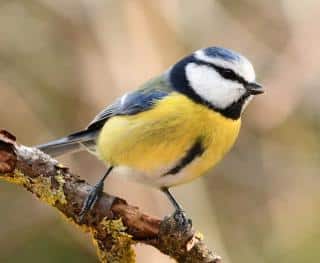 The colorful Cyanistes caeruleus has a yellow belly with blue to blue-green feathers on the back. Its face is white with one black line that runs at eye level, and another that flows down from the beak. The beak, also black, sings with shrill, high notes that speed up at the end of the singing.
The colorful Cyanistes caeruleus has a yellow belly with blue to blue-green feathers on the back. Its face is white with one black line that runs at eye level, and another that flows down from the beak. The beak, also black, sings with shrill, high notes that speed up at the end of the singing.
Fore-bearers of spring, the blue tit is only 5 inches long (12 cm). It loves shrubs, likes living in forests, in gardens, and occasionally in cities.
It feeds on larvae and fruit. Nonetheless, it will come visit bird feeders and snatch fallen breadcrumbs when it sees them!
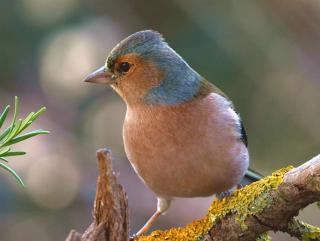 Fringilla coelebs makes are particularly colorful. Its face, belly, and part of its back are light brown. The top of its head is gray, and the rest of its feathers are either black and white. Females display a more gray, tan and brown range. Chaffinch lives in forest settings, but also visits gardens if they have lots of trees.
Fringilla coelebs makes are particularly colorful. Its face, belly, and part of its back are light brown. The top of its head is gray, and the rest of its feathers are either black and white. Females display a more gray, tan and brown range. Chaffinch lives in forest settings, but also visits gardens if they have lots of trees.
Chaffinches will eat anything, but they love eating insects above all else.
They hop around when picking food from the ground. Their songs are short with many interruptions, finishing off with rounder, richer notes.
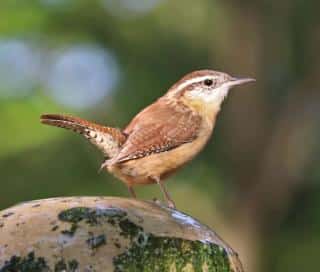 This little bundle of feathers has a brown back and tan belly. It’s quite small, barely reaching 4 inches (10 cm). It’s favorite environment is having lots of branches everywhere! It will hide in piles of branches, hedges, and in the crowns of trees. That’s why it’s quite common in gardens and in city parks.
This little bundle of feathers has a brown back and tan belly. It’s quite small, barely reaching 4 inches (10 cm). It’s favorite environment is having lots of branches everywhere! It will hide in piles of branches, hedges, and in the crowns of trees. That’s why it’s quite common in gardens and in city parks.
Insects and spiders are what it feeds on most. It captures them by pinning them to the ground with its beak.
Wrens are known for their strong, loud cry, a sound like goes “zui, zui”. Gardeners are often surprised at how loud such a small bird can be.
Read also → Attracting birds to your garden